
This political cartoon represents the challenging route immigrants face coming to America and trying to achieve citizenship.

This political cartoon represents the challenging route immigrants face coming to America and trying to achieve citizenship.
The article I found about immigration was titled “Physician emigration from Germany: insights from a survey in Saxony, Germany”. This article is a study based on the observation of physicians immigrating out of Germany to work elsewhere. Germany is facing a shortage of physicians, not due to a lack of people working to become physicians, but because these workers leave. The purpose of this research was to find what was pushing these physicians to leave.
In 2014 alone, 2364 physicians immigrated out of Germany to work in other countries like Austria, Switzerland, and the USA. This study surveyed over 2000 physicians and found that 29.5% wished to immigrate due to one or several factors. The most common reasons for wishing to leave were their overall satisfaction with their work situation, heavy work load, and lack of leisure time. Being female, in a relationship, or having children were common factors seen in those that did not wish to leave. This study also found that most of those interested in immigrating had already looked at options or taken steps to do so. Almost a third of those studied were unsure if they wanted to leave, which is a rather large amount of physicians unsure of wanting to stay. It was found that patient interactions were not a factor in the physicians wanting to leave, therefore leading to the possibly that the issue physicians are facing is with the structure of the medical system for which they are working. These physicians are wanting to leave not to flee anything horrendous, but instead to make a happier and better living for themselves, as we see with immigrant populations. Germany is my ancestral home, and though it was challenging to find information about immigration from this country in current times, this article stood out as an extremely thought provoking and important piece about the immigration possibilities faced in professional careers.
Citation:
Pantenburg, Birte, et al. “Physician Emigration from Germany: Insights from a Survey in Saxony, Germany.” BMC Health Services Research, vol. 18, no. 1, 2018, doi:10.1186/s12913-018-3142-6.
The article I chose as an opposing view of the Washington Post article is from NPR. This article creates a simple and seemingly unbiased presentation of part of the recent budget plan proposed by the Trump administration. This plan included cuts to the United State’s immigration services, especially those based in other countries. This article explains that the plan could save millions of dollars, but could also slow down refugee processing, family reunifications, and military citizenship applications. The article then goes on to explain that the United States Citizenship and Immigration Services agency could possibly outsource their work to U.S. embassies and consulates abroad as their department is cut back and offices are closed. A policy analyst at the Migration Policy Institute stated that the plan will likely lead to further processing strain for refugee applications.
This article utilized simple language that carried little to no emotional influence while presenting the facts of the topic. Much of the article consisted of direct quotes and exact descriptions of the actions of the analysts and agency heads involved. All information presented was relevant, well connected, and used in the correct context. There was no excessive use of adjectives, which can be seen in biased articles as a tool to sway a viewers opinion. This article seems to be a factual and trust worthy piece of news because of its attention to detail, straightforward language, and unbiased portrayal of a national concern.
Article:
https://www.npr.org/2019/03/12/702807908/trump-administration-seeks-to-close-international-immigration-offices
The article I chose highlights the recent attempt of change in policy by the President on the amount of refugees allowed to enter the country by adjusting the cap to about 30,000, the lowest since the U.S.’s refugee program’s creation. The article states that the new policy is not to allow most refugees in to the United States, which is to be accomplished by cutting international humanitarian aid and cut back within the Bureau of Population, Refugees and Migration. The new budget for this department would be slashed from 3 billion to 320 million dollars. Aid for hunger and natural disaster relief also were set to be cut back. This budget will not make it through Congress.
This article is from the Washington Post, and uses a great deal of emotional words. For example, just the title “Trump is turning his back on refugees — and America’s tradition of compassion” uses the imagery of turning refugees away in a violent manner, and suggests that Trump is as well throwing away the United States’ history of care for other countries. Throughout the article particular words are used to enhance the emotions being evoked by the reader. For example, instead of using the term “budget cut” to explain the de-funding to the Bureau of Population, Refugees and Migration, the article explains that the plan will “squash the operations nearly to nothingness”. This is a much more emotionally involved statement that utilizes imagery and strong words to create sympathy for the de-funding. Overall, this article uses factual information about the happenings of the planned budget, but has an noticeably liberal bias in the language and explanation of the administration’s plan.
Article Link: https://www.washingtonpost.com/opinions/trump-is-turning-his-back-on-refugees–and-americas-tradition-of-compassion/2019/03/14/c2ae92e8-45d3-11e9-aaf8-4512a6fe3439_story.html?noredirect=on&utm_term=.c05b918ca0b9
Having the opportunity to meet and hear the wisdom of Carlos Hernandez was an incredible time during which I felt I learned a great deal about the world of digital publishing and much more. First of all, I enjoyed listening to Hernandez speak about the way he writes and why he creates his pieces the way he does. These details had a lot to do with his background and his knowledge of the world that he has accumulated throughout his life. For example, he wrote his poem with slant rhymes and Spanish words in a piece mostly written in English to illustrate his cultural heritage, personal life experience, and how he has been influenced by other Spanish poetry (i.e. the slant rhymes). I think it is incredible how you can tell how much thought he puts into every word and phrase he uses within his writing.
Another part of Hernandez’s talk that I enjoyed was when he explained his relationship with his friend who he created the video game with. It is amazing when people are able and welcomed to join in on a project that they may not even have the “proper” experience to work on. The fact that his friend went out of his way to create a space for him that gave him the ability to write for the game goes to show how amazing of a writer he is. Friendships, random interests, and networking truly are great ways to jump start connections that could help you along your path, and Hernandez proved this in his stories of the people and friends he had that gave him incredible opportunities to further his career.
One last part of Hernandez’s talk that I remember well is when he explained the significance of digital publishing as it has affected people of color and women. It makes me so happy to know that people who for a long time had to jump through dozens of hoops and face rejection because of who they are now are at the highest ranks of writing in some settings. Hernandez explained so well how the best people to write about a culture are the people of that culture. People like Carlos Hernandez are an inspiration to writers of all ages, backgrounds, and skill levels, and it was a pleasure to be able to hear him speak on matters that he cares so deeply about.
My idea for the grant project involves working with AWE in a combination of their programs. Their “Hospitality Hours” program involves a class time centered around personal story writing and their “Employment and Education Program” involves resume writing and job placement assistance. My idea is to combine some of these skills in a way that puts these women’s stories and skills out into the world. This would involve seeing about working with the grant money to get a local newspaper or magazine to allow a couple pages as a place for refugees to write about their experience. The pages and articles would include personal stories from women that come to AWE, as well as also including a short biography like resume with their article that would include any special skills, education, or other information that would be a way to get their information out in an interesting and personal way to prospective employers. Through volunteering at the organization, Stevenson students could assist in this process as well! AWE already provides a lot of services and amazing programs, this plan could possibly bring not only more attention to the women writing their stories, but also to the organization and their purpose.
 The entrepreneurship career panel was an amazing opportunity to learn about the working world and what it takes to make your name in the world of business and sales. The panel included six speakers: John Dinkel, the principal of Dinkel Business Development, LLC, Chris Daley, Founder and Principal of Whirlaway, LLC, Elizabeth Trimm, Branch Manager of the largest Enterprise Rent-A-Car in the Baltimore Division, Andrew Murphy, Partner and Owner of Flying Frog Publishing, Andy Brown, Founder and CEO of “Eat Pizza”, and Garrett Pfeifer of Maryland Brand Management. Each of these entrepreneurs had interesting stories and great experience, but for me, the ones that stuck out the most were Elizabeth Trimm, Andrew Murphy, and Andy Brown. I liked listening to Ms. Trimm speak because of her take-charge attitude; she was not ashamed of her talents in sales and I really respected that she could tell stories like one she did about making more than her bosses and managers when she worked as a sales person. Mr. Murphy had a very captivating way of speaking that could easily keep my attention; he mentioned at one point that to run a business connecting all the pieces and people that you need to work with as one is key to success. He also mentioned the importance of finding people you want to do business with to make your business work. Lastly, Mr. Brown was an interesting panelist as he, similar to Trimm, talked about how he just kept outdoing his bosses or coming up with better business plans than them. Brown also spoke on re-crafting your plan as you go; your plan can’t always stay the same and your approach has to change as your business does.
The entrepreneurship career panel was an amazing opportunity to learn about the working world and what it takes to make your name in the world of business and sales. The panel included six speakers: John Dinkel, the principal of Dinkel Business Development, LLC, Chris Daley, Founder and Principal of Whirlaway, LLC, Elizabeth Trimm, Branch Manager of the largest Enterprise Rent-A-Car in the Baltimore Division, Andrew Murphy, Partner and Owner of Flying Frog Publishing, Andy Brown, Founder and CEO of “Eat Pizza”, and Garrett Pfeifer of Maryland Brand Management. Each of these entrepreneurs had interesting stories and great experience, but for me, the ones that stuck out the most were Elizabeth Trimm, Andrew Murphy, and Andy Brown. I liked listening to Ms. Trimm speak because of her take-charge attitude; she was not ashamed of her talents in sales and I really respected that she could tell stories like one she did about making more than her bosses and managers when she worked as a sales person. Mr. Murphy had a very captivating way of speaking that could easily keep my attention; he mentioned at one point that to run a business connecting all the pieces and people that you need to work with as one is key to success. He also mentioned the importance of finding people you want to do business with to make your business work. Lastly, Mr. Brown was an interesting panelist as he, similar to Trimm, talked about how he just kept outdoing his bosses or coming up with better business plans than them. Brown also spoke on re-crafting your plan as you go; your plan can’t always stay the same and your approach has to change as your business does.
This event speaks well to the focus of our class: making a statement with your product. Of course, for digital publishing, you are working your hardest to make your work stand out and achieve its purpose by making it call out to your audience through proper visuals, text, and layout. In a business you are trying to achieve the similar goal of reaching an audience, but the considerations are more comprehensive as a whole company is being pushed to sell a product. Digital publishing can actually be an enormous part of running and advertising a business, especially with the rise of solely online businesses. As for my career path, which is nursing, there’s not too much I can do to apply entrepreneurship to my work. Yet, outside of my career path, I work for my family’s bar, creating flyers, advertisements, and social media pages. So I do have some involvement in the work of digital creations and this panel helped me to focus my attention better on outreach to the consumer and progressing business plans.
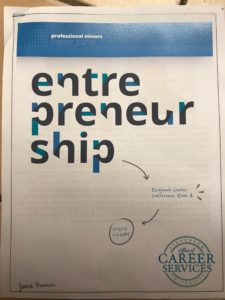
When a struggle comes of the improper treatment of human beings, assistance and care is a sought after tool in the process of rebuilding the lives of those hurt. Hundreds of nonprofits organizations exist to help immigrants and migrants in a time when being of assistance to these peoples is necessary to the care of humanity. This essay will analyze the ability and design of a nonprofit’s website and their efforts to use an cyber platform to spread their message of humanitarian assistance. The website lirs.org for the Lutheran Immigration and Refugee Service is an online center that utilizes bold imagery and sophisticated text organization to call the people of America to serve and aid those in situations of need through volunteerism, donations, and direct action.
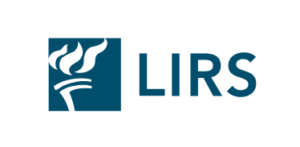
The intended audience of this web-page is possible donors and volunteers for the Lutheran Immigration and Refugee Service. The homepage of this website is geared towards American English speakers as it explains everything about the organization in English and uses the American iconic image of the Statue of Liberty’s torch. The top bar of web-page, which remains on the site regardless of the page you enter, contains a large orange squared off button that says “DONATE” in all capital letters as well as a section titled “TAKE ACTION” with a pull-down bar that contains linked pages titled “Advocate”, “Host an Event”, “Volunteer”, and “Give” (“Lutheran Immigration and Refugee Service”). The push for these actions and the fact that they are made to be found easily illustrates that these actions are what the author wishes the intended audience to notice. As for a secondary audience, this website also provides specific posts and links that give resources to refugees. Examples of these resources include the direct link in the very top right corner of the page that allows those in need of financial assistance to sign-up or sign in to an account for travel loans as well as a top bar “Resources” pull-down. The secondary audience of this web-page also could be those brought into being involved in the website through the social media or social gathering aspects of the organization’s promotions like the speaker events which people can volunteer to host.
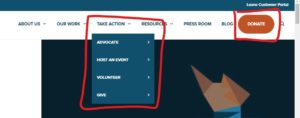
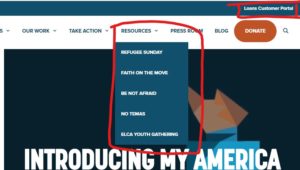
The author of this page, the Lutheran Immigration and Refugee Service (LIRS) organization, does an excellent job at pushing the services and pages they want seen by their audience in a simple and easily accessible way. For example, along with the top bar that provides straightforward navigation of the site’s tools, the home page includes a large section focused on something called “My America”, which includes a button allowing you to read stories of those that have moved to America as refugees. They wish to persuade the reader into joining the cause by assisting in some fashion as recommended on the website. This gives the audience an immediate idea of the importance refugees have to this organization. The webpage includes a section devoted to the organization’s history under the “About Us” profile. LIRS was established in 1939 by Lutheran churches to help and serve people in need during WWII (“Lutheran Immigration and Refugee Service”). There is even a book written on LIRS, which highlights their many years of service. They have a vast history in this line of work and have proved themselves to be a truly important asset to asylum-seekers and migrants (“Lutheran Immigration and Refugee Service”).
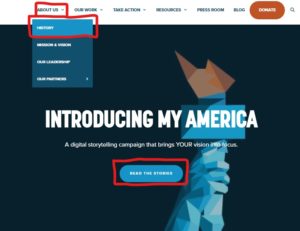

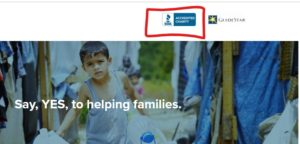
This website allows for a large audience as it is publicly and widely accessible. The use of a common payment input and charity accreditation when you click the “Donate” button allows for simple and safe donations for potential donors. This is an example of how a website is an advantageous context for an organization seeking funds from contributors. As the refugee crisis has been an extensively spoken about topic in recent years, and is only continuing to become more relevant, websites and organizations like LIRS are gaining visitation and possibly support, making of these groups very socially relevant. This web-page is designed well enough to be used properly and efficiently on any device. Someone could pull up the web-page on their phone and see the same information and nearly the same layout as someone searching the site on their desktop computer. This aspect of the design allows for people to research and access by any means necessary in any environmental context. The use of large imagery across the homepage and many other pages is meant to draw the user’s attention to pertinent sections or stories. The use of big and simple text allows for easy reading, making it more accessible to those with vision and reading difficulties.
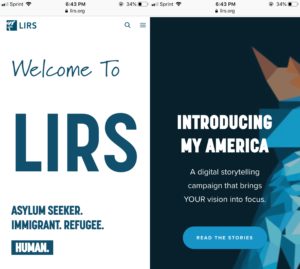
The Lutheran Immigration and Refugee Service has many intentions for their web-page. Most importantly, they are seeking assistance from outsiders to broaden their abilities for assisting and serving refugees in need. This is exemplified again in the way the site is setup to have simple access to tools that allow the user to donate their time or efforts to the cause within the top bar of the website.

LIRS is also looking to help refugees directly. The site’s straightforward navigation of tools to assist refugees gives those with this need who do have possible access to the internet a place to go to figure out what they can do and what help they can receive. Another purpose behind LIRS’s web-page is to educate. This site gives information about their work and about the situations that migrants and asylum seekers are coming from, as listed under their “Our Work” section. This provided information teaches those who are unaware of the issue and the need there is for assistance why helping is necessary (“Lutheran Immigration and Refugee Service”).
The genre of the LIRS website is humanitarian and nonprofit. Firstly, you can tell the website is a nonprofit simple because it is a charity organization that is categorized as a nonprofit. Though, upon further inspection and comparison, it is easy to see that LIRS is quite similar to that of many other charity organizations, as it implements a simply organized web-page using large images that catch attention, bold, large, and easy to read text, donor and volunteer options, and information about their beginning and mission. We can also tell that LIRS is humanitarian because their work is solely based in assisting with the welfare of immigrants and migrants. There is no other apparent line of work for this organization, it was founded and continues to work for the lives of those who have been misplaced and need help.

Building a online environment to draw attention to a need or purpose can be a challenge to creators. Using proper imagery and text layout to make an online text appealing and generally understandable is an important feat in the world of cyber communications. The people behind LIRS have done a wonderful job of persuading their audience in assisting refugees and migrants of the world through the use of their conveniently and well designed website.
Works Cited:
“Lutheran Immigration and Refugee Service.” LIRS, 6 Feb. 2019, www.lirs.org/.